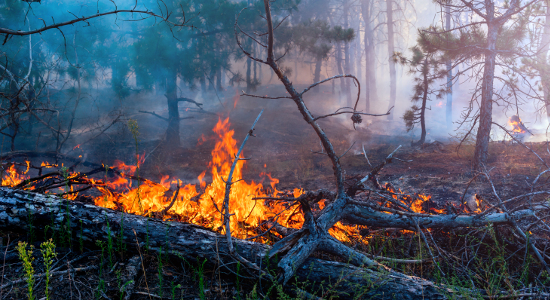
Oct. 30, 2018 – In a unanimous decision, the Wisconsin Supreme Court recently applied a “cause theory” to limit coverage for damages that property owners sustained in the 2013 “Germann Road Fire,” a forest fire that burned more than 7,300 acres.
Logging equipment caused the blaze when a spark triggered a grass fire and quickly spread to surrounding forest land. For three days, it burned across Douglas and Bayfield counties, destroying more than 100 structures, including more than 20 homes.
Ray Duerr Logging LLC owned the logging equipment that sparked the blaze. Duerr Logging had a commercial general liability (CGL) policy with Secura Insurance. The CGL policy had a $2 million cap, regardless of the number of “occurrences.”
But an endorsement limited coverage to $500,000 “per occurrence” for property damage “due to fire, arising from logging or lumbering operations.”
Thus, Secura argued that the Germann Road Fire was a single occurrence caused by logging operations, and the $500,000 cap applied, not the $2 million aggregate cap.
The property owners, of course, argued that the $2 million cap applied. They said a separate occurrence was triggered each time the fire crossed a property line. The circuit court concluded that the $2 million cap applied, and a state appeals court affirmed.
But in Secura Insurance v. Ray Duerr Logging LLC, 2018 WI 103 (Oct. 30, 2018), the first non-disciplinary decision of the term, the state supreme court was fully united in reversing the lower court rulings, concluding the $500,000 cap applies.
“By focusing not on the cause of the damage, but on the effect on individual property owners, the court of appeals strayed from this court’s established methodology for determining the number of occurrences,” wrote Justice Ann Walsh Bradley.
Not Like Falk
The court noted that in determining whether an event constitutes a single occurrence or multiple occurrences for purposes of insurance coverage, the “cause theory” controls.
Under the cause theory, it is one accident or occurrence if “a single, uninterrupted cause results in all of the injuries and damage,” Justice A.W. Bradley explained.
If an average person would view the “cause” and resulting damage as closely linked in time and space, then the court will generally view the “cause” as a single occurrence. The court viewed the spark and resulting forest fire as closely linked in time and space.
The property owners relied on a 2014 decision – Wilson Mut. Ins. Co. v. Falk, 2014 WI 136, 360 Wis. 2d 67, 857 N.W.2d 156 – to argue that the fire triggered a separate occurrence each time it crossed a property line, just as liquid fertilizer triggered a separate occurrence each time it infiltrated and contaminated a different well.
But the supreme court said “there are significant factual differences between a forest fire and the seepage of manure into a well,” noting that in Falk, the manure used to fertilize the defendant’s farmland “seeped over the course of an unspecified time.”
The fire burned continuously for three days. “A three-day fire in a discrete area caused by a single precipitating event would reasonably be considered by the average person to be one event,” Justice A.W. Bradley wrote. “Regardless of how many property lines the fire crossed, the damage closely follows the cause in both time and space.”
The supreme court said the circumstances more closely resemble a case involving a bicyclist struck by a vehicle, which caused an injury. Then, further injuries occurred when the driver stopped, but pulled forward, dragging the bicyclist underneath the car.
More injuries occurred when a second driver attempted to free the bicyclist by backing the car up 10 feet. The court ruled this was one event, not multiple occurrences.
The court noted that other jurisdictions have ruled that a fire damaging multiple properties is still a single event, for insurance purposes, and ruling otherwise could have “arbitrary and unreasonable consequences,” something Secura’s counsel had argued.
“It is arbitrary to determine the number of occurrences solely from the number of owners whose property is damaged,” Justice A.W. Bradley wrote.
“Under the court of appeals' analysis, the fire could have burned exactly the same amount of land over exactly the same amount of time, but if all the land were owned by one person instead of several, the fire would constitute but one occurrence.
“Such a result would force the insurer to pay more in the event that the same amount of land burned is split among several owners.”
